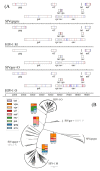Site-Specific Evolutionary Rate Shifts in HIV-1 and SIV
- PMID: 33207801
- PMCID: PMC7696578
- DOI: 10.3390/v12111312
Site-Specific Evolutionary Rate Shifts in HIV-1 and SIV
Abstract
Site-specific evolutionary rate shifts are defined as protein sites, where the rate of substitution has changed dramatically across the phylogeny. With respect to a given clade, sites may either undergo a rate acceleration or a rate deceleration, reflecting a site that was conserved and became variable, or vice-versa, respectively. Sites displaying such a dramatic evolutionary change may point to a loss or gain of function at the protein site, reflecting adaptation, or they may indicate epistatic interactions among sites. Here, we analyzed full genomes of HIV and SIV-1 and identified 271 rate-shifting sites along the HIV-1/SIV phylogeny. The majority of rate shifts occurred at long branches, often corresponding to cross-species transmission branches. We noted that in most proteins, the number of rate accelerations and decelerations was equal, and we suggest that this reflects epistatic interactions among sites. However, several accessory proteins were enriched for either accelerations or decelerations, and we suggest that this may be a signature of adaptation to new hosts. Interestingly, the non-pandemic HIV-1 group O clade exhibited a substantially higher number of rate-shift events than the pandemic group M clade. We propose that this may be a reflection of the height of the species barrier between gorillas and humans versus chimpanzees and humans. Our results provide a genome-wide view of the constraints operating on proteins of HIV-1 and SIV.
Keywords: HIV; cross-species transmission; phylogenetics; rate shifts.
Conflict of interest statement
The authors declare no conflict of interest.
Figures



Similar articles
-
Experimental Adaptive Evolution of Simian Immunodeficiency Virus SIVcpz to Pandemic Human Immunodeficiency Virus Type 1 by Using a Humanized Mouse Model.J Virol. 2018 Jan 30;92(4):e01905-17. doi: 10.1128/JVI.01905-17. Print 2018 Feb 15. J Virol. 2018. PMID: 29212937 Free PMC article.
-
Mimicking SIV chimpanzee viral evolution toward HIV-1 during cross-species transmission.J Med Primatol. 2020 Oct;49(5):284-287. doi: 10.1111/jmp.12485. Epub 2020 Aug 17. J Med Primatol. 2020. PMID: 33460210 Free PMC article.
-
AIDS. Origins of HIV.Science. 2000 Jun 9;288(5472):1757-9. doi: 10.1126/science.288.5472.1757. Science. 2000. PMID: 10877695
-
Simian immunodeficiency virus infection of chimpanzees.J Virol. 2005 Apr;79(7):3891-902. doi: 10.1128/JVI.79.7.3891-3902.2005. J Virol. 2005. PMID: 15767392 Free PMC article. Review. No abstract available.
-
The history of SIVS and AIDS: epidemiology, phylogeny and biology of isolates from naturally SIV infected non-human primates (NHP) in Africa.Front Biosci. 2004 Jan 1;9:225-54. doi: 10.2741/1154. Front Biosci. 2004. PMID: 14766362 Review.
Cited by
-
Modeling the evolution of SARS-CoV-2 under non-pharmaceutical interventions and testing.Evol Med Public Health. 2022 Apr 18;10(1):179-188. doi: 10.1093/emph/eoac013. eCollection 2022. Evol Med Public Health. 2022. PMID: 35498119 Free PMC article.
-
Shifts in amino acid preferences as proteins evolve: A synthesis of experimental and theoretical work.Protein Sci. 2021 Oct;30(10):2009-2028. doi: 10.1002/pro.4161. Epub 2021 Aug 12. Protein Sci. 2021. PMID: 34322924 Free PMC article. Review.
-
Evolution of Amino Acid Propensities under Stability-Mediated Epistasis.Mol Biol Evol. 2022 Mar 2;39(3):msac030. doi: 10.1093/molbev/msac030. Mol Biol Evol. 2022. PMID: 35134997 Free PMC article.
-
One Health Perspectives on New Emerging Viral Diseases in African Wild Great Apes.Pathogens. 2021 Oct 6;10(10):1283. doi: 10.3390/pathogens10101283. Pathogens. 2021. PMID: 34684232 Free PMC article. Review.
-
Molecular Evolution of the Fusion (F) Genes in Human Parainfluenza Virus Type 2.Microorganisms. 2025 Feb 12;13(2):399. doi: 10.3390/microorganisms13020399. Microorganisms. 2025. PMID: 40005765 Free PMC article.
References
Publication types
MeSH terms
Substances
LinkOut - more resources
Full Text Sources

